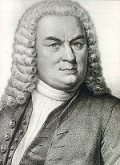
Johann Sebastian Bach
Among the best-loved examples from Bach's wide-ranging legacy are undoubtedly the Brandenburg Concertos. They also provide a marvelous way to get your feet wet with Bach: they epitomize much of what makes him such a towering figure yet are immensely enjoyable and easy to approach on first hearing.
In 1721, Bach pulled together examples of his work for small instrumental groups in response to a request from a Prussian prince--the "Brandenburg" of the title, who earned a thoroughly undeserved immortality from that fact, having put the priceless collection on the shelf and ignored it. The Brandenburg Concertos come from different points in Bach's early career, but as reworked and assembled into this package of six (a layout he favored, as in the Cello Suites or English Suites, for instance), they summarize the state of the art of the concerto and even anticipate the musical future.
The Latin root of "concerto" encapsulates the dual aspect of this musical genre, which had been pioneered before Bach by Italian composers such as Arcangelo Corelli and Antonio Vivaldi. It means a diverse body of musicians playing together "in concert," but it also suggests a kind of contest in which solo players (alone or in small groups) are pitted against a larger group.
Normally, the format calls for three movements following the pattern fast-slow-fast. The Brandenburgs incorporate all of these senses and more, in a way that no one had done before Bach, who modestly labeled the package "concertos with several instruments"--one of the great understatements in the history of music.
The most striking thing you'll notice immediately is how varied these pieces are in their combinations of "several instruments." Bach never uses the same (or even a similar) line-up of instruments twice.
The first is one of the more "orchestral," with its strings, winds, and punchy horns, while the second contrasts a surprising and delectable quartet of trumpet, recorder, oboe, and violin soloists against the standard strings and continuo (which provides the harmonic "backup"). The harpsichord, normally playing continuo in the background, rises to stunning solo prominence in the fifth (arguably the very first in a line leading to the solo keyboard concerto that Mozart would bring to perfection), and the fourth turns at moments into a tour-de-force solo violin concerto.

Trevor Pinnock
Using just strings and continuo, the third and sixth explore remarkably different textures: a darker, amber sound dominates in the latter owing to the absence of violins. All of this results in an amazing kaleidoscope of combined instrumental colors, which are brought to the fore in these dazzling performances by the English Concert with Trevor Pinnock - they absolutely pulse with joyously spunky energy.
Yet--and this is completely characteristic of Bach--the music's encyclopedic range is the furthest thing from dry-as-dust, pedantic academicism. Rather, Bach invests these works with a dynamic, compelling vitality, so that they give rise to another kind of polyphony; that is, they can appeal to many different levels at once.
Bach is a master at homing in on a particular emotion and keeping our interest focused on feeling it intensely. There's no mistaking the high spirits that radiate through most of the quicker movements, while the slow movements of the second and fifth concertos touch with an immediate pathos. There's a sensual appeal in the variety of colors, and simultaneously a deeply satisfying stimulation of the intellect in these pieces' architecture and masterful complexity.
This recording by Trevor Pinnock is one of the finest ever. Played on original baroque instruments, the sound is a little thinner than what we are used to with modern orchestras. This is not a fault - it is actually an advantage. It brings Bach to life - every instrument is heard clearly, the feel is gutsy, real, lively. This is the Brandenburgs as Bach himself would have heard it. Wonderful stuff.
Please support Good-Music-Guide.com
by purchasing this CD using this link.

Track Listing
Johann Sebastian Bach
Six Brandenburg Concertos
Four Orchestral Suites
The English Concert
Trevor Pinnock
Disc 1
Concerto No.1 BWV 1046
- ohne Satzbezeichnung
- Adagio
- Allegro
- Menuetto - Trio 1 - Polacca - Trio 2
Concert No.2 BWV 1047
- ohne Satzbezeichnung
- Andante
- Allegro assai
Concerto No.3 BWV 1048
- ohne Satzbezeichnung
- Adagio
- Allegro
Concerto No.4 BWV 1049
- Allegro
- Andante
- Presto
Disc 2
Concerto No.5 BWV 1050
- Allegro
- Affettuoso
- Allegro
Concerto No.6 BWV 1051
- ohne Satzbezeichnung
- Adagio ma non tanto
- Allegro
Orchestral Suite No.1 BWV 1066
- Ouverture
- Courante
- Gavotte 1-2
- Forlane
- Menuet 1-2
- Bourree 1-2
- Passepied 1-2
Disc 3
Orchestral Suite No.2 BWV 1067
- Ouverture
- Rondeau
- Sarabande
- Bourree 1-2
- Polonaise
- Menuet
- Badinerie
Orchestral Suite No.3 BWV 1068
- Ouverture
- Air
- Gavotte 1-2
- Bourree
- Gigue
Orchestral Suite No.4 BWV 1069
- Ouverture
- Bourree 1-2
- Gavotte
- Menuet 1-2
- Rejouissance